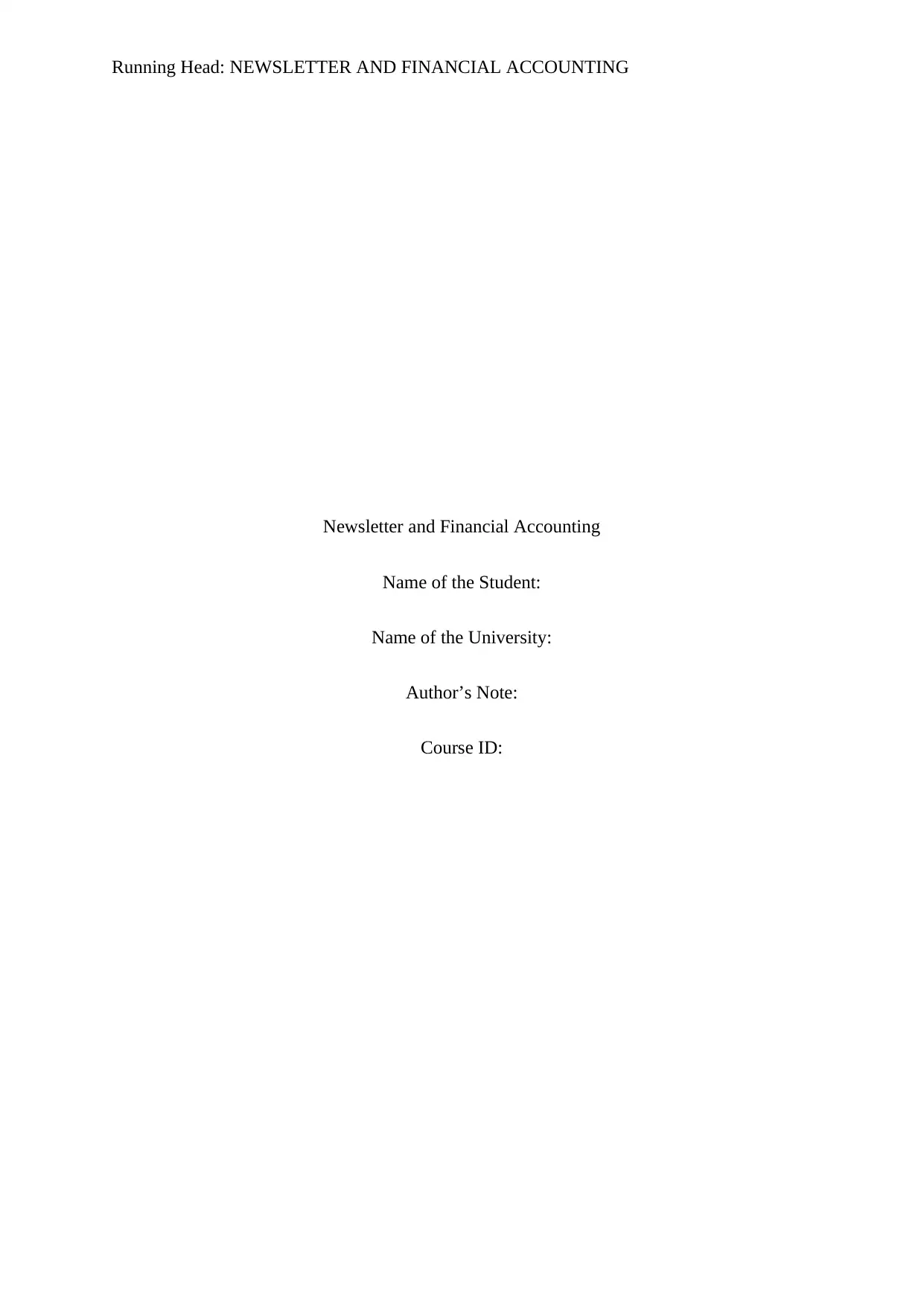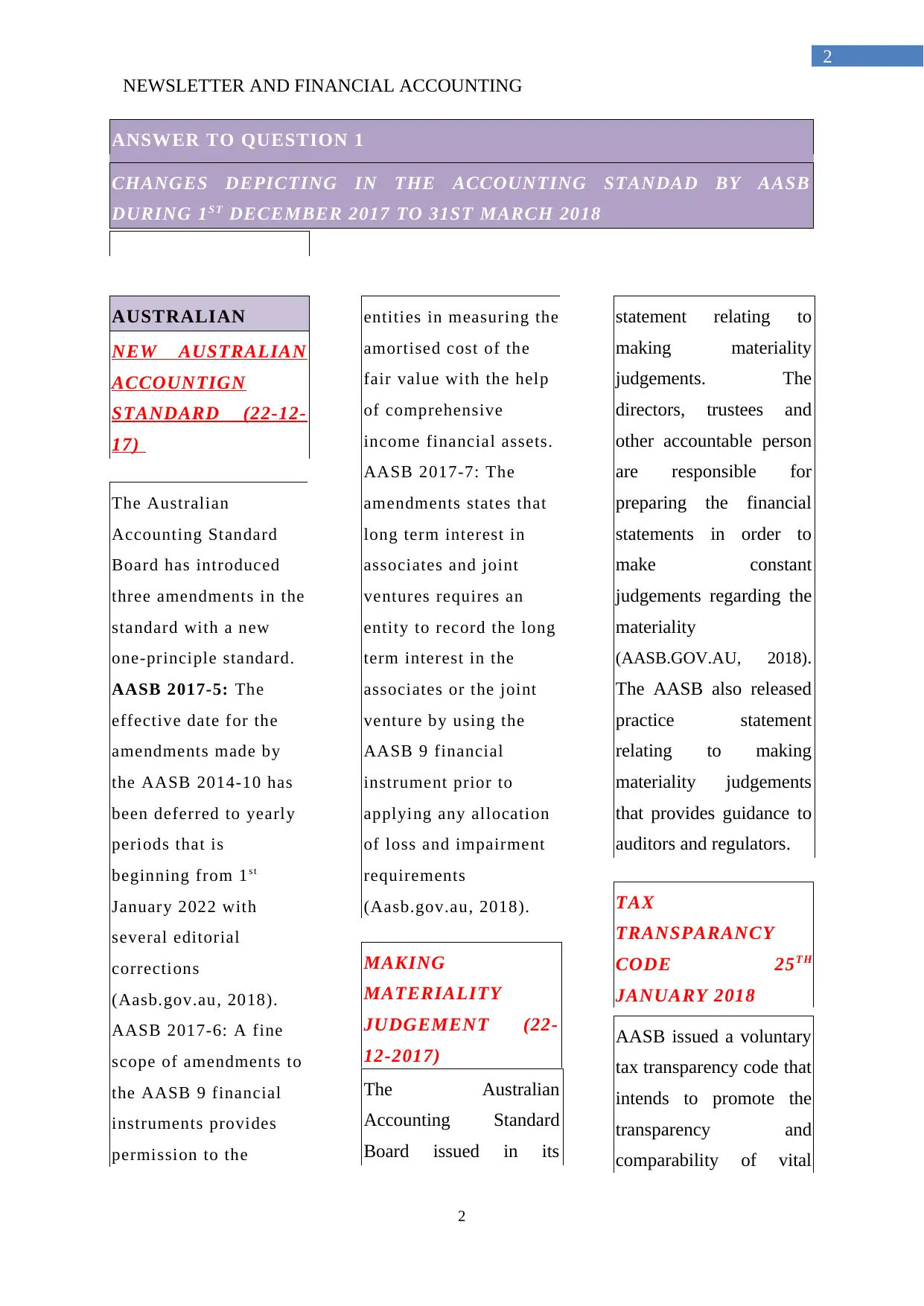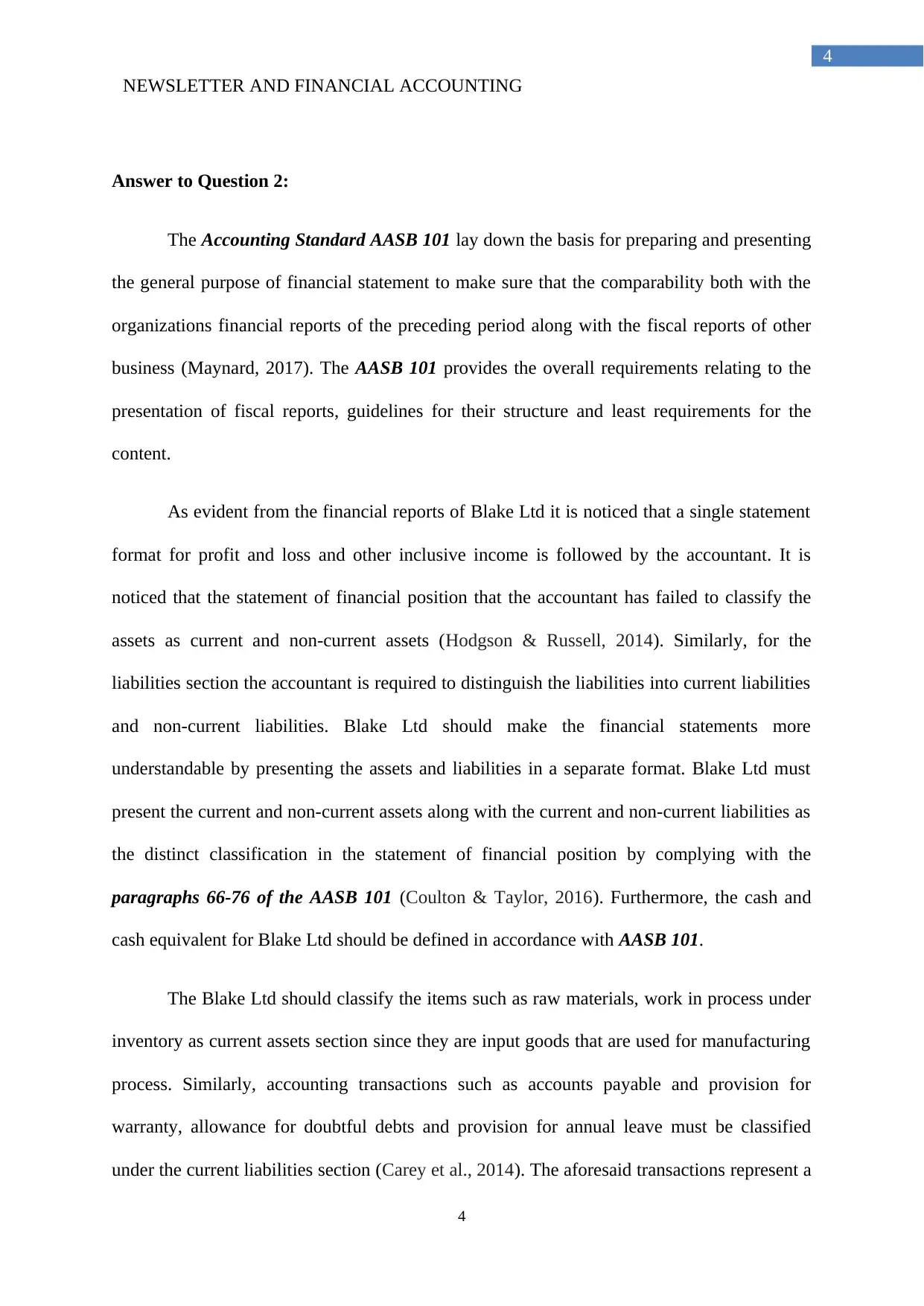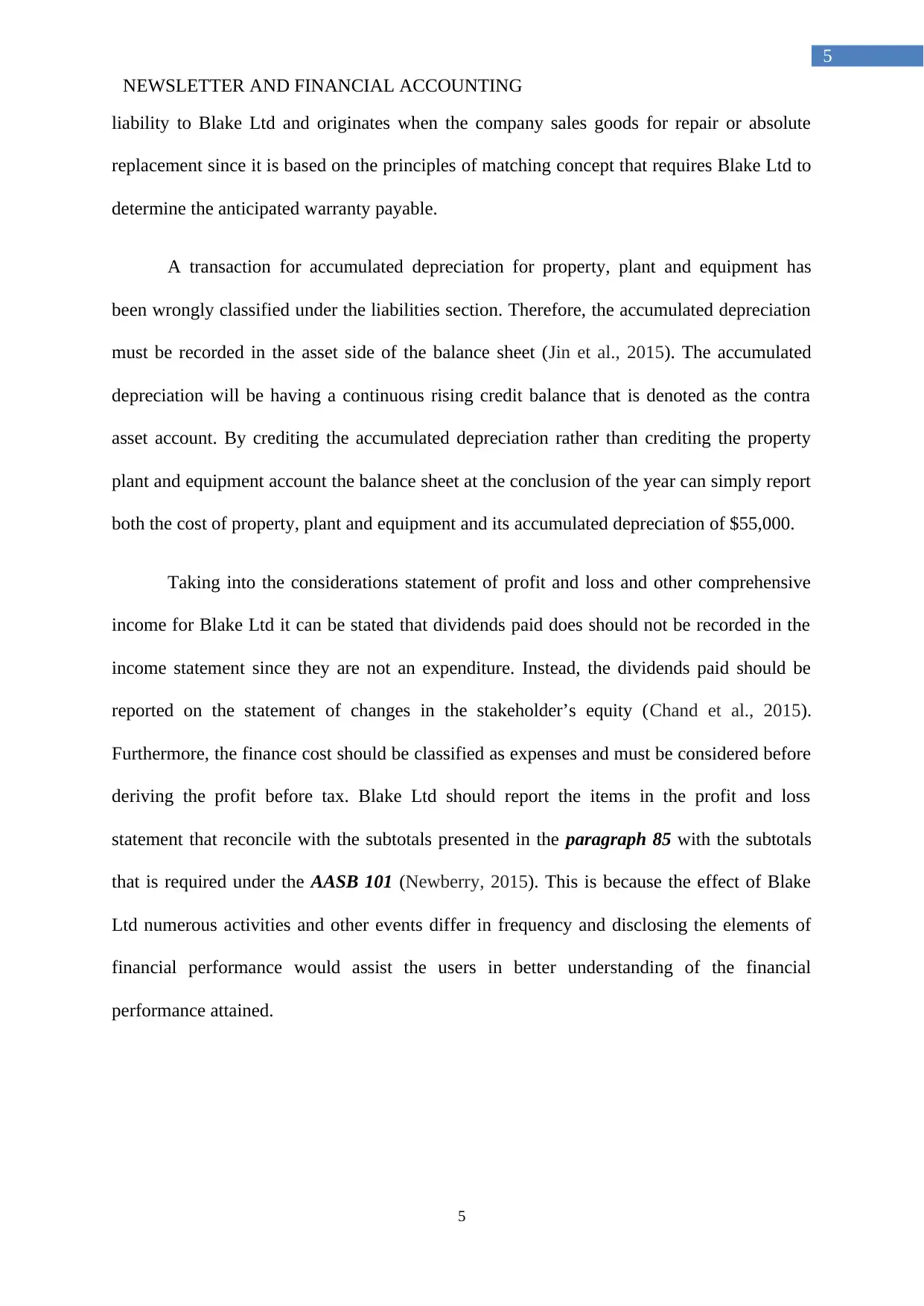Financial Accounting Newsletter: Standards and Analysis
VerifiedAdded on 2021/04/21
|6
|1434
|25
Report
AI Summary
This report provides an overview of recent changes and updates to Australian Accounting Standards (AASB) from December 2017 to March 2018. It summarizes key amendments, including those related to financial instruments, materiality judgments, tax transparency, and financial reporting for charities. The report also analyzes the application of AASB 101, focusing on the preparation and presentation of financial statements. The report provides a detailed analysis of a company's financial statements (Blake Ltd), highlighting areas of non-compliance with AASB 101 and suggesting improvements in the presentation of assets, liabilities, and income statements. The report emphasizes the importance of correct classification of assets, liabilities, and expenses, and the need for accurate reporting of financial performance. Finally, the report concludes with a comprehensive list of references used for research and analysis.

Running Head: NEWSLETTER AND FINANCIAL ACCOUNTING
Newsletter and Financial Accounting
Name of the Student:
Name of the University:
Author’s Note:
Course ID:
Newsletter and Financial Accounting
Name of the Student:
Name of the University:
Author’s Note:
Course ID:
Paraphrase This Document
Need a fresh take? Get an instant paraphrase of this document with our AI Paraphraser

2
NEWSLETTER AND FINANCIAL ACCOUNTING
ANSWER TO QUESTION 1
CHANGES DEPICTING IN THE ACCOUNTING STANDAD BY AASB
DURING 1ST DECEMBER 2017 TO 31ST MARCH 2018
AUSTRALIAN
NEW AUSTRALIAN
ACCOUNTIGN
STANDARD (22-12-
17)
The Australian
Accounting Standard
Board has introduced
three amendments in the
standard with a new
one-principle standard.
AASB 2017-5: The
effective date for the
amendments made by
the AASB 2014-10 has
been deferred to yearly
periods that is
beginning from 1s t
January 2022 with
several editorial
corrections
(Aasb.gov.au, 2018).
AASB 2017-6: A fine
scope of amendments to
the AASB 9 financial
instruments provides
permission to the
entities in measuring the
amortised cost of the
fair value with the help
of comprehensive
income financial assets.
AASB 2017-7: The
amendments states that
long term interest in
associates and joint
ventures requires an
entity to record the long
term interest in the
associates or the joint
venture by using the
AASB 9 financial
instrument prior to
applying any allocation
of loss and impairment
requirements
(Aasb.gov.au, 2018).
MAKING
MATERIALITY
JUDGEMENT (22-
12-2017)
The Australian
Accounting Standard
Board issued in its
statement relating to
making materiality
judgements. The
directors, trustees and
other accountable person
are responsible for
preparing the financial
statements in order to
make constant
judgements regarding the
materiality
(AASB.GOV.AU, 2018).
The AASB also released
practice statement
relating to making
materiality judgements
that provides guidance to
auditors and regulators.
TAX
TRANSPARANCY
CODE 25T H
JANUARY 2018
AASB issued a voluntary
tax transparency code that
intends to promote the
transparency and
comparability of vital
2
NEWSLETTER AND FINANCIAL ACCOUNTING
ANSWER TO QUESTION 1
CHANGES DEPICTING IN THE ACCOUNTING STANDAD BY AASB
DURING 1ST DECEMBER 2017 TO 31ST MARCH 2018
AUSTRALIAN
NEW AUSTRALIAN
ACCOUNTIGN
STANDARD (22-12-
17)
The Australian
Accounting Standard
Board has introduced
three amendments in the
standard with a new
one-principle standard.
AASB 2017-5: The
effective date for the
amendments made by
the AASB 2014-10 has
been deferred to yearly
periods that is
beginning from 1s t
January 2022 with
several editorial
corrections
(Aasb.gov.au, 2018).
AASB 2017-6: A fine
scope of amendments to
the AASB 9 financial
instruments provides
permission to the
entities in measuring the
amortised cost of the
fair value with the help
of comprehensive
income financial assets.
AASB 2017-7: The
amendments states that
long term interest in
associates and joint
ventures requires an
entity to record the long
term interest in the
associates or the joint
venture by using the
AASB 9 financial
instrument prior to
applying any allocation
of loss and impairment
requirements
(Aasb.gov.au, 2018).
MAKING
MATERIALITY
JUDGEMENT (22-
12-2017)
The Australian
Accounting Standard
Board issued in its
statement relating to
making materiality
judgements. The
directors, trustees and
other accountable person
are responsible for
preparing the financial
statements in order to
make constant
judgements regarding the
materiality
(AASB.GOV.AU, 2018).
The AASB also released
practice statement
relating to making
materiality judgements
that provides guidance to
auditors and regulators.
TAX
TRANSPARANCY
CODE 25T H
JANUARY 2018
AASB issued a voluntary
tax transparency code that
intends to promote the
transparency and
comparability of vital
2

3
NEWSLETTER AND FINANCIAL ACCOUNTING
information regarding the
entities situation of tax.
Upon the request of board
of tax, a draft guidance
has been issued by AASB
to help entities during the
performance of suggested
tax reconciliation with
effective tax computation
rate.
FINANCIAL
REPORTING
FRAMEWORK FOR
CHARITIES (14-02-
2018)
As the part of the AASB
financial reporting
framework it released a
research paper based on
the present financial
reporting requirements
for charities. The purpose
was to increase the
conversation relating to
financial reporting in the
charity sector that can be
enhanced. It encourages
the constituents to make
submission to ACNC
review.
ANNUAL
IMPROVEMENTS
TO 2015-17 CYCLE
(23-02-2018)
The objective of this
standard is to make
amendments in respect of
interest that are held
previously in the joint
operation, consequences
of income tax payments
on the financial
instrument that are
classified as equity with
borrowing costs being
eligible for compensation.
AASB REDUCED
DISCLOSURE
REQUIREMENTS
(21-12-2017)
The reduced disclosure
requirements offer
disclosure concessions for
the Tier-2 entities relating
to AASB 16 Leases. In
comparison to Tier 1, Tier
2 disclosure significantly
helps in reducing the
burden of disclosure
along with the cost of
preparing and auditing
GPFS for large number of
entities irrespective of
profit and non-profit
entities (AASB.GOV.AU,
2018).
AUSTRALIAN
IMPLEMENTATION
GUIDANCE FOR
NFP PUBLIC
SECTOR
LICENSORS: ED
(21-12-17)
The standard is developed
to reduce the diversity
involved in accounting
for revenue generated
from licences that issued
by the public sector
entities (AASB.GOV.AU,
2018). ED 283 provides
amendments to assist
public sector licensors in
distinguishing licenses
from taxes and
determining the nature of
licences issued.
3
NEWSLETTER AND FINANCIAL ACCOUNTING
information regarding the
entities situation of tax.
Upon the request of board
of tax, a draft guidance
has been issued by AASB
to help entities during the
performance of suggested
tax reconciliation with
effective tax computation
rate.
FINANCIAL
REPORTING
FRAMEWORK FOR
CHARITIES (14-02-
2018)
As the part of the AASB
financial reporting
framework it released a
research paper based on
the present financial
reporting requirements
for charities. The purpose
was to increase the
conversation relating to
financial reporting in the
charity sector that can be
enhanced. It encourages
the constituents to make
submission to ACNC
review.
ANNUAL
IMPROVEMENTS
TO 2015-17 CYCLE
(23-02-2018)
The objective of this
standard is to make
amendments in respect of
interest that are held
previously in the joint
operation, consequences
of income tax payments
on the financial
instrument that are
classified as equity with
borrowing costs being
eligible for compensation.
AASB REDUCED
DISCLOSURE
REQUIREMENTS
(21-12-2017)
The reduced disclosure
requirements offer
disclosure concessions for
the Tier-2 entities relating
to AASB 16 Leases. In
comparison to Tier 1, Tier
2 disclosure significantly
helps in reducing the
burden of disclosure
along with the cost of
preparing and auditing
GPFS for large number of
entities irrespective of
profit and non-profit
entities (AASB.GOV.AU,
2018).
AUSTRALIAN
IMPLEMENTATION
GUIDANCE FOR
NFP PUBLIC
SECTOR
LICENSORS: ED
(21-12-17)
The standard is developed
to reduce the diversity
involved in accounting
for revenue generated
from licences that issued
by the public sector
entities (AASB.GOV.AU,
2018). ED 283 provides
amendments to assist
public sector licensors in
distinguishing licenses
from taxes and
determining the nature of
licences issued.
3
⊘ This is a preview!⊘
Do you want full access?
Subscribe today to unlock all pages.

Trusted by 1+ million students worldwide

4
NEWSLETTER AND FINANCIAL ACCOUNTING
Answer to Question 2:
The Accounting Standard AASB 101 lay down the basis for preparing and presenting
the general purpose of financial statement to make sure that the comparability both with the
organizations financial reports of the preceding period along with the fiscal reports of other
business (Maynard, 2017). The AASB 101 provides the overall requirements relating to the
presentation of fiscal reports, guidelines for their structure and least requirements for the
content.
As evident from the financial reports of Blake Ltd it is noticed that a single statement
format for profit and loss and other inclusive income is followed by the accountant. It is
noticed that the statement of financial position that the accountant has failed to classify the
assets as current and non-current assets (Hodgson & Russell, 2014). Similarly, for the
liabilities section the accountant is required to distinguish the liabilities into current liabilities
and non-current liabilities. Blake Ltd should make the financial statements more
understandable by presenting the assets and liabilities in a separate format. Blake Ltd must
present the current and non-current assets along with the current and non-current liabilities as
the distinct classification in the statement of financial position by complying with the
paragraphs 66-76 of the AASB 101 (Coulton & Taylor, 2016). Furthermore, the cash and
cash equivalent for Blake Ltd should be defined in accordance with AASB 101.
The Blake Ltd should classify the items such as raw materials, work in process under
inventory as current assets section since they are input goods that are used for manufacturing
process. Similarly, accounting transactions such as accounts payable and provision for
warranty, allowance for doubtful debts and provision for annual leave must be classified
under the current liabilities section (Carey et al., 2014). The aforesaid transactions represent a
4
NEWSLETTER AND FINANCIAL ACCOUNTING
Answer to Question 2:
The Accounting Standard AASB 101 lay down the basis for preparing and presenting
the general purpose of financial statement to make sure that the comparability both with the
organizations financial reports of the preceding period along with the fiscal reports of other
business (Maynard, 2017). The AASB 101 provides the overall requirements relating to the
presentation of fiscal reports, guidelines for their structure and least requirements for the
content.
As evident from the financial reports of Blake Ltd it is noticed that a single statement
format for profit and loss and other inclusive income is followed by the accountant. It is
noticed that the statement of financial position that the accountant has failed to classify the
assets as current and non-current assets (Hodgson & Russell, 2014). Similarly, for the
liabilities section the accountant is required to distinguish the liabilities into current liabilities
and non-current liabilities. Blake Ltd should make the financial statements more
understandable by presenting the assets and liabilities in a separate format. Blake Ltd must
present the current and non-current assets along with the current and non-current liabilities as
the distinct classification in the statement of financial position by complying with the
paragraphs 66-76 of the AASB 101 (Coulton & Taylor, 2016). Furthermore, the cash and
cash equivalent for Blake Ltd should be defined in accordance with AASB 101.
The Blake Ltd should classify the items such as raw materials, work in process under
inventory as current assets section since they are input goods that are used for manufacturing
process. Similarly, accounting transactions such as accounts payable and provision for
warranty, allowance for doubtful debts and provision for annual leave must be classified
under the current liabilities section (Carey et al., 2014). The aforesaid transactions represent a
4
Paraphrase This Document
Need a fresh take? Get an instant paraphrase of this document with our AI Paraphraser

5
NEWSLETTER AND FINANCIAL ACCOUNTING
liability to Blake Ltd and originates when the company sales goods for repair or absolute
replacement since it is based on the principles of matching concept that requires Blake Ltd to
determine the anticipated warranty payable.
A transaction for accumulated depreciation for property, plant and equipment has
been wrongly classified under the liabilities section. Therefore, the accumulated depreciation
must be recorded in the asset side of the balance sheet (Jin et al., 2015). The accumulated
depreciation will be having a continuous rising credit balance that is denoted as the contra
asset account. By crediting the accumulated depreciation rather than crediting the property
plant and equipment account the balance sheet at the conclusion of the year can simply report
both the cost of property, plant and equipment and its accumulated depreciation of $55,000.
Taking into the considerations statement of profit and loss and other comprehensive
income for Blake Ltd it can be stated that dividends paid does should not be recorded in the
income statement since they are not an expenditure. Instead, the dividends paid should be
reported on the statement of changes in the stakeholder’s equity (Chand et al., 2015).
Furthermore, the finance cost should be classified as expenses and must be considered before
deriving the profit before tax. Blake Ltd should report the items in the profit and loss
statement that reconcile with the subtotals presented in the paragraph 85 with the subtotals
that is required under the AASB 101 (Newberry, 2015). This is because the effect of Blake
Ltd numerous activities and other events differ in frequency and disclosing the elements of
financial performance would assist the users in better understanding of the financial
performance attained.
5
NEWSLETTER AND FINANCIAL ACCOUNTING
liability to Blake Ltd and originates when the company sales goods for repair or absolute
replacement since it is based on the principles of matching concept that requires Blake Ltd to
determine the anticipated warranty payable.
A transaction for accumulated depreciation for property, plant and equipment has
been wrongly classified under the liabilities section. Therefore, the accumulated depreciation
must be recorded in the asset side of the balance sheet (Jin et al., 2015). The accumulated
depreciation will be having a continuous rising credit balance that is denoted as the contra
asset account. By crediting the accumulated depreciation rather than crediting the property
plant and equipment account the balance sheet at the conclusion of the year can simply report
both the cost of property, plant and equipment and its accumulated depreciation of $55,000.
Taking into the considerations statement of profit and loss and other comprehensive
income for Blake Ltd it can be stated that dividends paid does should not be recorded in the
income statement since they are not an expenditure. Instead, the dividends paid should be
reported on the statement of changes in the stakeholder’s equity (Chand et al., 2015).
Furthermore, the finance cost should be classified as expenses and must be considered before
deriving the profit before tax. Blake Ltd should report the items in the profit and loss
statement that reconcile with the subtotals presented in the paragraph 85 with the subtotals
that is required under the AASB 101 (Newberry, 2015). This is because the effect of Blake
Ltd numerous activities and other events differ in frequency and disclosing the elements of
financial performance would assist the users in better understanding of the financial
performance attained.
5

6
NEWSLETTER AND FINANCIAL ACCOUNTING
REFERENCES:
Maynard, J. (2017). Financial accounting, reporting, and analysis. Oxford University Press.
Hodgson, A., & Russell, M. (2014). Comprehending comprehensive income. Australian
Accounting Review, 24(2), 100-110.
COULTON, J. R. A. S. Y., & TAYLOR, S. (2016). The rise and rise of non-GAAP
disclosure.
Carey, P., Potter, B., & Tanewski, G. (2014). AASB Research Report No.
Jin, K., Shan, Y., & Taylor, S. (2015). Matching between revenues and expenses and the
adoption of International Financial Reporting Standards. Pacific-Basin Finance Journal, 35,
90-107.
Chand, P., Patel, A., & White, M. (2015). Adopting international financial reporting
standards for small and medium‐sized enterprises. Australian Accounting Review, 25(2), 139-
154.
Newberry, S. (2015). Public sector accounting: shifting concepts of accountability. Public
Money & Management, 35(5), 371-376.
News. (2017). Aasb.gov.au. Retrieved 16 March 2018, from
http://www.aasb.gov.au/News.aspx
6
NEWSLETTER AND FINANCIAL ACCOUNTING
REFERENCES:
Maynard, J. (2017). Financial accounting, reporting, and analysis. Oxford University Press.
Hodgson, A., & Russell, M. (2014). Comprehending comprehensive income. Australian
Accounting Review, 24(2), 100-110.
COULTON, J. R. A. S. Y., & TAYLOR, S. (2016). The rise and rise of non-GAAP
disclosure.
Carey, P., Potter, B., & Tanewski, G. (2014). AASB Research Report No.
Jin, K., Shan, Y., & Taylor, S. (2015). Matching between revenues and expenses and the
adoption of International Financial Reporting Standards. Pacific-Basin Finance Journal, 35,
90-107.
Chand, P., Patel, A., & White, M. (2015). Adopting international financial reporting
standards for small and medium‐sized enterprises. Australian Accounting Review, 25(2), 139-
154.
Newberry, S. (2015). Public sector accounting: shifting concepts of accountability. Public
Money & Management, 35(5), 371-376.
News. (2017). Aasb.gov.au. Retrieved 16 March 2018, from
http://www.aasb.gov.au/News.aspx
6
⊘ This is a preview!⊘
Do you want full access?
Subscribe today to unlock all pages.

Trusted by 1+ million students worldwide
1 out of 6
Related Documents
Your All-in-One AI-Powered Toolkit for Academic Success.
+13062052269
info@desklib.com
Available 24*7 on WhatsApp / Email
![[object Object]](/_next/static/media/star-bottom.7253800d.svg)
Unlock your academic potential
Copyright © 2020–2025 A2Z Services. All Rights Reserved. Developed and managed by ZUCOL.




